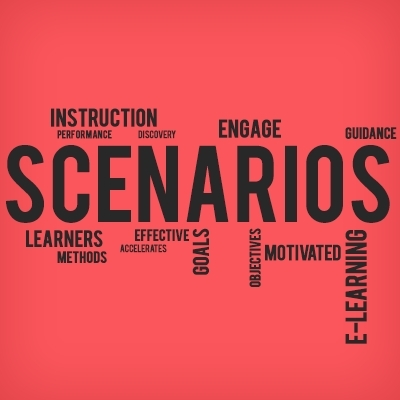Follow Story-Based And Scenario-Based Learning Approaches To Create Engaging eLearning
Consider this scenario where you are teaching a technical course on various forms of gasoline that includes the concept of using shock absorber. The topic may begin with a splash animation, followed by learning objectives followed by the definition and uses of Shock Absorber.
However, what if you start off the course with an actual case of a driver who has not used the right shock absorber fluid and meeting with an accident? Would not that be a more compelling beginning to the course?
A story-based or scenario-based learning approach to teaching this concept can help learners immerse themselves into the course better. The learnability and memorability quotient of the course increases. I will delve into these aspects more next.
Creating The Right Engagement Through Master Scenarios Or A Story That Weaves The Entire Course
There are several approaches to use the story-based or scenario-based learning approach. I found 2 approaches actually working quite well.
Using Master Scenarios
In this type of engagement, we start off the course with a master scenario that sets the context for the entire course. For example, a Project Management course can start off through a discussion between a senior project manager and 2 juniors. Here, the juniors are for example confounded by a set of project management problems or issues that they are facing. Later in the course, reference is provided to the master scenario to recall key issues and solve them. Here, I opine that scenario-based learning approach works well.
A Story For The Entire Course
In this approach, learners are being presented with a story at the beginning of the course, and it is weaved throughout the course in all the screens. The story progresses in increments and concludes at the end. Using this type of format, the learner is engaged throughout as he/she can relate to the story well. An example of this kind of approach would be to start with the story of a person who has joined an organization as a junior manager. The manager meets several members of the personnel. The story-based or scenario-based learning approach during his journey and the key concepts are taught as he moves along the journey.
Let’s look at the examples or cases now:
Case 1: Active Listening (Master Scenario)
Soft skills, like communication and body language, are essential in today’s world to succeed. We developed a demo on 'active listening' for a customer using the story-based approach. In a typical day of a salesperson’s life, the salesperson visits many customers and needs to interact, negotiate and close deals.
Thus, we started the course with the story of a salesperson who visits a prospect and commits many mistakes. The story goes like this, John a Sales executive visits a prospect and starts talking about the product. The prospect initially shows interest and starts asking few questions. However, even before he completes the question, the salesperson answers the question. Further, during the discussion, the salesperson fiddles with his Mobile phone looks distracted and is in a hurry to close the deal without addressing any of the pain points of the prospect. The prospect inevitably gets angry and asks the salesperson to leave.
The story sets the context for the course on what is active listening, and how it can be used as an effective tool to create the right engagement with the other party. Active listening can be used in several situations whether they are sales calls or training sessions. Thus, the scenario-based learning approach was quite useful in this case.

Case 2: Compliance Course Using The Story Throughout
Compliance can be quite dry and boring for the recipients. As it is a mandatory training, most of the employees show little interest in the course but focus on completing it. For a customer, we decided to go against the grain, and instead of giving a regular course on compliance, we used a storytelling/scenario-based learning approach to make the course interesting.
Here, we introduced a character, Peter who joins an organization and needs to go through the compliance training. At the beginning of the course, we provided background information about the organization and the mandatory compliance aspects that the organization needs to adhere to.
Then, we showed how Peter moved around and met various people in the organization to know more about the other aspects of compliance using dialogues. The story thus moves forward using this approach. We mixed up the story with various interactivities or activities that the learner needs to perform to move forward. The story-based approach thus helped the learner to remain engaged throughout the course.

Conclusion
We have looked at 2 case studies on using master scenarios and stories in creating a course. Hope you have enjoyed it and decided to give me your valuable feedback on the article.
Custom Courses With A Storytelling Approach
At Tesseract Learning, our Instructional Designers constantly look at ways of making courses engaging and meaningful. We use a variety of techniques, with storytelling being one of them. We find the story-based or scenario-based learning approach to be quite universal, though we need strong support from the SME’s to help blend the story with the main content. Without SME support, we will not able to provide the right contextualization. As you know, communication is always a two-way street.
We use LXD or learning experience design in a way that the courses that we build are useful and meaningful to our audiences.
To learn more about how story-based and scenario-based learning approaches can fit your needs, do reach out to me to contact me or leave a comment below with your feedback and suggestion.
Suggested further reading:
- Story-Based Learning: How Good Storytelling In eLearning Can Engage Learners In A Meaningful Way
- Benefits Of Aligning Training To Company Vision And Brand









